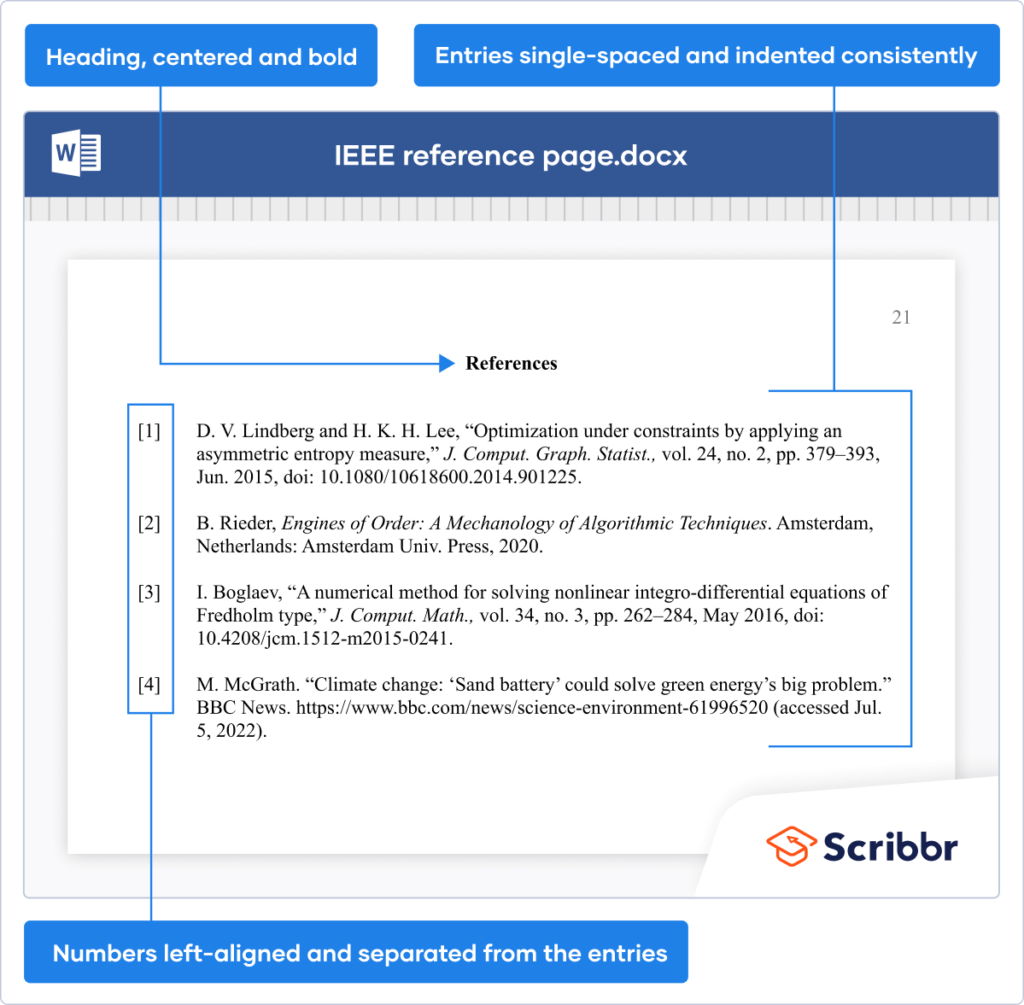IEEE Reference Page | Example & Format
The IEEE reference page (sometimes called the IEEE bibliography) appears at the end of your paper. It’s where you list full information about all the sources you’ve cited, numbered to match your IEEE in-text citations, so that the reader can find and consult them.
Follow these guidelines to format the reference page:
- Write the heading ‘References’ in bold at the top, either left-aligned or centred.
- Write the reference numbers down the left side, in square brackets.
- Indent the references themselves consistently to separate them from the numbers.
- Single-space the references, with a normal paragraph break in between them.
Example of an IEEE reference page
Example references for common source types
IEEE references follow specific formatting guidelines in order to provide full information on the source in a clear and consistent way. This generally consists of the author’s name, the title of the source, the publication date, and information about where it was published.
Examples are shown below for common source types.
IEEE book citation
| IEEE book citation format | Author initials. Last name, Book Title. City (and state if in US), Country: Publisher, Year. |
|---|---|
| IEEE reference | J. P. Hailman, Coding and Redundancy: Man-Made and Animal-Evolved Signals. Cambridge, MA, USA: Harvard Univ. Press, 2008. |
IEEE journal article citation
| IEEE journal article citation format | Author initials. Last name, “Article title,” Journal Name, vol. Volume, no. Number, pp. Page range, Month Year, DOI. |
|---|---|
| IEEE reference | J. Kou, “Estimating the number of clusters via the GUD statistic,” J. Comput. Graph. Statist., vol. 23, no. 2, pp. 403–417, Jun. 2014, doi: 10.1080/10618600.2013.778778. |
IEEE website citation
| IEEE website citation format | Author initials. Last name. “Page title.” Website Name. URL (accessed Month Day, Year). |
|---|---|
| IEEE reference | B. Fung. “Amazon offers concessions to resolve EU antitrust probes.” CNN.com. https://edition.cnn.com/2022/07/14/tech/amazon-concessions-eu-antitrust/index.html (accessed Jul. 18, 2022). |
Numbering and ordering the reference list
In IEEE citation format, your references are numbered to match the in-text citations that point the reader towards them. In-text citations and references are both numbered in the order they were cited in the text.
If you cite the same source repeatedly in your paper, it’s numbered based on the first time it was cited and appears only once on the reference page. To cite different parts of a source, use a different page number (or other locator) in each in-text citation. Don’t create duplicate references.
As you edit your paper, always double-check that the numbering of in-text citations still matches that on the reference page, or your citations will point to the wrong references.
General formatting guidelines for IEEE references
While many details of your IEEE references vary based on the type of source you’re citing, there are some general rules about:
Authors
Give the initials of the author’s first name and (if listed) middle name, and write their last name in full. Each initial is followed by a period and a space.
For a source with one to six authors, list all of them, separated by commas and (before the final one) the word ‘and.’ Write the names in the order they’re listed in the source. If there are seven or more, list the first author followed by ‘et al.’ (italicised).
| 1 author | A. Bleda, … |
|---|---|
| 2 authors | A. Bleda and M. L. Reyna, … |
| 3–6 authors | A. Bleda, M. L. Reyna, J. Gabriel-Rodriguez, T. Primula, and Y. Vivianus, … |
| 7+ authors | A. Bleda et al., … |
Titles
Titles are formatted in two basic ways in IEEE references, depending on whether it’s the title of something that stands on its own, or the title of something that’s part of a larger publication:
- Titles of standalone sources and containers (e.g., books, journals) are written in italics, with title case capitalisation (capitalising the first letter of all important words).
- Titles of sources contained in a larger publication (e.g., chapters in a book, journal articles) are enclosed in quotation marks, with only the first word (and any proper nouns) capitalised.
Abbreviations
To keep references concise, IEEE recommends abbreviating the names of publishers, journals, universities, companies, conferences, and months (as well as using initials for authors’ names, as described above).
Months are all abbreviated to the first three letters, followed by a period (e.g., ‘Jun.’; but no period after May, since it’s already three letters long).
This table lists abbreviations for some other common words. A more comprehensive table can be accessed through the button below. Note that these words are only abbreviated in the contexts mentioned above, not in source titles.
| American | Amer. | Mathematical / mathematics | Math. |
|---|---|---|---|
| Computational / computer(s) / computing | Comp. | Proceedings | Proc. |
| Conference | Conf. | Report | Rep. |
| Department | Dept. | Research | Res. |
| Electrical | Elect. | Science | Sci. |
| Electronic | Electron. | Statistics | Statist. |
| Engineering | Eng. | Technical | Tech. |
| Information | Inf. | Technology | Technol. |
| Journal | J. | Telecommunications | Telecommun. |
| Machine | Mach. | University | Univ. |
Frequently asked questions about IEEE reference page
Cite this Scribbr article
If you want to cite this source, you can copy and paste the citation or click the ‘Cite this Scribbr article’ button to automatically add the citation to our free Reference Generator.
Caulfield, J. (2022, August 24). IEEE Reference Page | Example & Format. Scribbr. Retrieved 14 April 2025, from https://www.scribbr.co.uk/ieee-referencing/ieee-reference-list/




